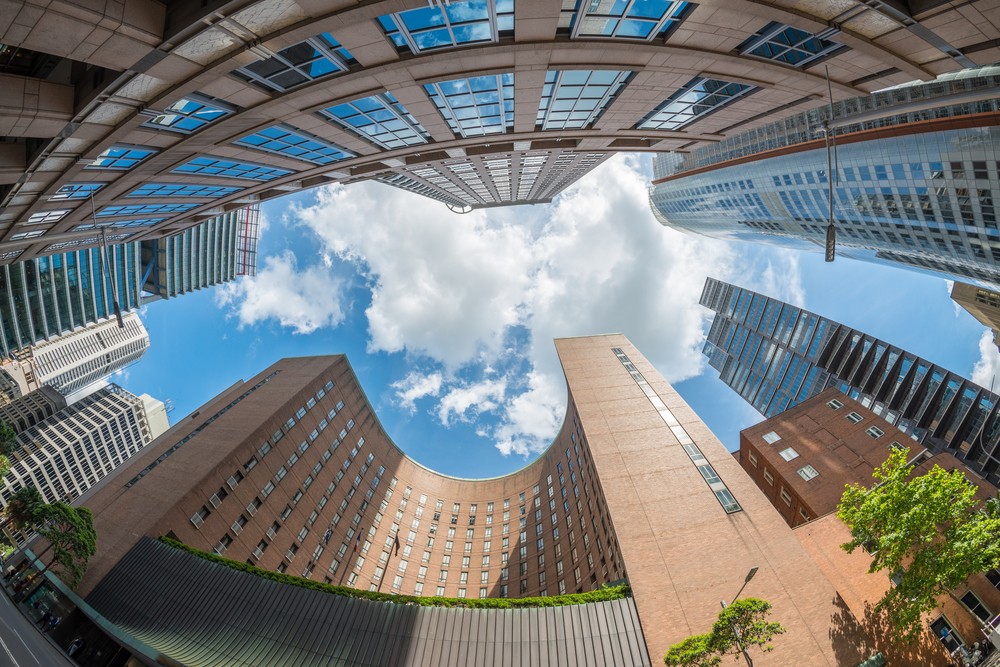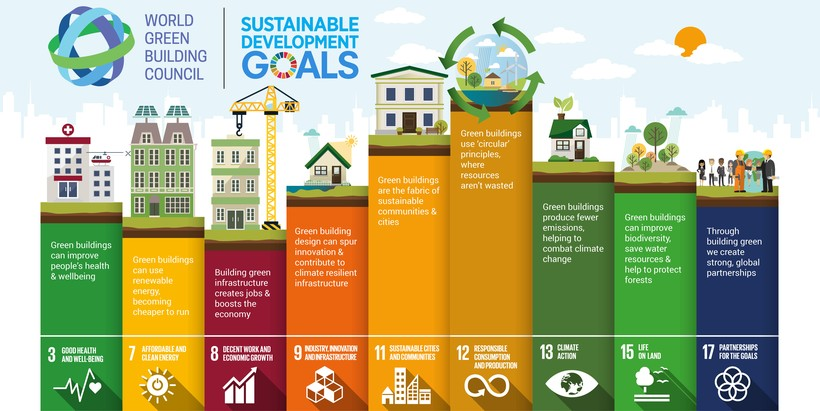
January 1st 2016 marked a key milestone in our collective efforts to “promote prosperity while protecting the planet” as world leaders agreed, and brought into force, the UN’s Sustainable Development Goals (SDGs). These goals set forth a challenge for humanity to decouple economic growth from climate change, poverty and inequality… and this is a challenge that we firmly believe green building can help to solve.
While many might look at a building and see only an inanimate structure, we look at buildings and see both the physicality and the process by which they are created – an opportunity to not only save energy, water and carbon emissions but to educate, create jobs, strengthen communities, improve health and wellbeing, and much, much more. Green building is a true catalyst for addressing some of the world’s most pressing issues.
While the 17 goals are wide ranging, from ending hunger to promoting peaceful and inclusive societies, each with detailed targets to be achieved over the next 15 years, there are several goals to which we believe green buildings can, and in fact already have, been contributing to in a significant way.
Goal 3: GOOD HEALTH & WELLBEING - Ensure healthy lives and promote wellbeing for all at all ages
There is now overwhelming evidence which suggests the way a building is designed can affect the health and wellbeing of its occupants. According to the World Health Organization, lung and respiratory diseases associated with poor indoor environment quality are three of the top five leading causes of death.
But green building features, such as improved lighting, better air quality and greenery, have been proven to positively impact health and wellbeing, and this agenda has gained increasing momentum over the last few years. Our Better Places for People global project is focused on creating a world in which buildings are not only good for the environment, but also support healthier, happier and more productive lives.
And reducing emissions from buildings – particularly in cities – can reduce pollution and improve air quality, benefiting the health of city dwellers.

The many ways in which green buildings can contribute to the SDGs. Image: World GBC
Goal 7: AFFORDABLE & CLEAN ENERGY - Ensure access to affordable, reliable, sustainable and modern energy for all
The cheapest energy is the energy we don’t use, and energy savings from efficient, green buildings - whether commercial office buildings or homes - are often one of the most talked about benefits. Green buildings also use renewables energy, which can be cheaper than fossil fuel alternatives.
For example, the International Renewable Energy Agency (IRENA) suggests home solar systems in Africa can provide households with electricity for as low as $56 a year – much cheaper than energy from diesel or kerosene. Renewable energy also has the additional benefit of producing no carbon emissions, limiting the impact on the planet. Energy efficiency coupled with local renewable sources also improves energy security.
Goal 8: DECENT WORK & ECONOMIC GROWTH - Promote inclusive and sustainable economic growth, employment and decent work for all
As the demand for green building grows globally, so does the workforce required to deliver them, and this is another goal that green building can significantly contribute to. For example, the green building industry in Canada represented nearly 300,000 full-time jobs in 2014.
What’s more, the life-cycle of a green building – from conception to construction, operation and even renovation - impacts a wide variety of people, providing even more opportunities for inclusive employment.
And some Green Building Councils such as South Africa have developed ways to integrate more complex socio-economic issues such as unemployment or lack of skills into green building rating systems – creating further incentives for businesses to consider these criteria in their developments.
Goal 9: INDUSTRY, INNOVATION & INFRASTRUCTURE - Build resilient infrastructure, promote sustainable industrialisation and foster innovation
Green buildings are not only about the here and now. They must be designed in a way that ensures they are resilient and adaptable in the face of our changing global climate. This is critically important in developing countries, many of which will be particularly susceptible to the effects of climate change.
But it’s not just about future proof buildings, but the spaces in between – the infrastructure that must be equally as sustainable and resilient to future risks. A recent report from the New Climate Economy found that US$90 trillion of investment worldwide is needed in the next 15 years in the infrastructure sector to achieve a prosperous, net zero emissions future.
And striving for buildings which push the boundaries on sustainability, such as net zero emissions buildings, is also a major driver for innovation and technology.
Goal 11: SUSTAINABLE CITIES & COMMUNITIES - Make cities inclusive, safe, resilient and sustainable
Almost 60 per cent of the world’s population will live in urban areas by 2030, and so ensuring they are sustainable is of paramount importance. Buildings are the foundations of cities, and green buildings are therefore key to their long-term sustainability. Whether it’s homes, offices, schools, shops or green spaces – the built environment contributes to the make-up of communities, which must be sustainable to ensure a high quality of life for all.
In fact, in many countries, Green Building Councils have moved beyond the certification of single green buildings and have developed tools that facilitate the formation of green neighborhoods and districts. Others, such as the Philippines GBC, have helped cities like Mandaue to develop and implement policies that promote sustainable building practices across entire cities.
Goal 12: RESPONSIBLE CONSUMPTION & PRODUCTION - Ensure sustainable consumption and production patterns
This goal focuses on promoting resource and energy efficiency, sustainable infrastructure, and providing access to basic services and green jobs. The building industry has a major role to play in preventing waste through reduction, recycling and reuse – ‘circular economy’ principles where resources are not wasted.
Our movement includes leading product manufacturers such as Shaw Contract who have developed ways to generate products – in this case carpet – from what was previously considered to be waste, known as the “cradle to cradle” approach. This not only reduces the amount of waste going to landfill but also reduces the amount of raw materials that are being extracted from the earth.
Since 2006, Shaw has reclaimed and recycled more than 400 million kilograms of post-consumer carpet.
“
Green building is a true catalyst for addressing some of the world’s most pressing issues.
Goal 13: CLIMATE ACTION - Take urgent action to combat climate change and its impacts
Buildings are responsible for over 30 per cent of global green house gas emissions, and are therefore a major contributor to climate change. But by the same token, green buildings have huge potential to combat it, offering one of the most cost effective ways to do so, through measures such as energy efficiency. For example, South Africa’s Green Star certified buildings save 336 million kilograms of carbon emissions a year – the same as taking 84,000 cars off the roads – helping to limit the effects of climate change.
Goal 15: LIFE ON LAND - Sustainably manage forests, combat desertification, halt and reverse land degradation, halt biodiversity loss
The materials that make up a building are key to determining its sustainability. And so the building industry and its supply chains have a major role to play in using responsibly sourced materials such as timber. Green building certification tools also recognise the need to reduce water use, and the value of biodiversity and the importance of ensuring it is protected, and incorporate this into the space they build on both during and after construction - minimising damage and designing ways to enhance biodiversity, such as through landscaping with local flora.
Goal 17: PARTNERSHIPS FOR THE GOALS - Revitalise the global partnership for sustainable development
Historically, the building industry has lacked a collective voice on the world stage at major climate change conferences and has often not been recognised for the huge opportunities it presents. In 2015, a significant milestone was achieved when WorldGBC, UNEP, the French government and several other organisations came together to host the first ever “Buildings Day” as part of the official COP21 agenda and to launch the Global Alliance for Building and Construction.
A year and a half on, and our movement is already seeing the benefits of having a seat at the table. Strong new partnerships such as those with the World Resources Institute and the Global Environmental Facility have been secured, increasing our capacity to drive change and ensure that we are all building on one another’s strengths rather than re-inventing the wheel.
Our movement has long recognised that the barriers to a sustainable built environment are not technical solutions but rather how we effectively collaborate, ensuring our collective efforts are truly aligned to achieve much greater impact.
When it comes to the remaining SDGs, direct links between them and green buildings may be less explicit, but that’s not to say they don’t exist at all.
For example, there are a number of educational opportunities created through the process of creating green buildings - the training of professionals in sustainability issues or green building techniques – and by our individual Green Building Councils through their own educational programmes.
The International Labour Organisation (ILO) has recognised this opportunity by partnering with Green Building Councils, for example in Zambia, to deliver local green jobs programmes. And responsible businesses and organisations working in and around the building and construction industry are helping to breakdown sexism and promote gender equality in the green building workplace.
Nearly 50 per cent of our Established Green Building Councils are led by women, and C40 Cities’ Women4Climate initiative is also highlighting the role women are playing on climate action.
In Australia, as the Green Star certification scheme is revised, the Green Building Council of Australia is looking towards assisting building developers and owners to report on specific criteria against 16 of the 17 SDGs – demonstrating just how relevant they are to our industry.
For all of these reasons, we believe that the green building movement will mean significant progress in decoupling economic growth from climate change, poverty and inequality, helping to achieve the goals and creating a greener world that we can all be proud to call home.
